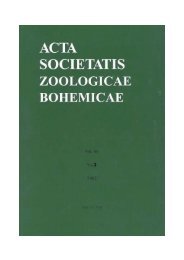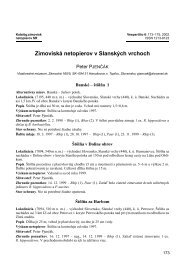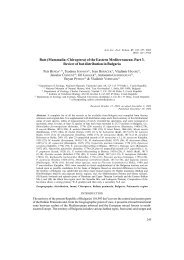Create successful ePaper yourself
Turn your PDF publications into a flip-book with our unique Google optimized e-Paper software.
Jiří Zachariáš – Marta PudilováTh-CO2 (L + V to L; °C)35302520151050-5PrimaryPseudosecondary-10-62.0 -61.5 -61.0 -60.5 -60.0 -59.5 -59.0 -58.5 -58.0 -57.5 -57.0 -56.5Tm-CO 2 (°C)Fig. 3. Aqueous-carbonic fluid inclusions: CO 2-melting (Tm-CO 2) vs. CO 2-homogenization (Th-CO 2) relationshipsof primary and pseudosecondary inclusions.FrequencyFrequency12108642012108642Primary(103 data)-10 -8 -6 -4 -2 0 2 4 6 8 10 12 14 16 18 20 22 24 26 28 30Th-CO (°C, to L)0-10Pseudosecondary(27 data)-8 -6 -4 -2 0 2 4 6 8 10 12 14 16 18 20 22 24 26 28 30Th-CO 2 (°C, to L)Fig. 4. Histograms of CO 2-homogenization temperatures for primary and pseudosecondary inclusions.Fluid inclusion petrographyTwo basic types of fluids were identified: aqueous-carbonicand aqueous. The aqueous-carbonic fluid inclusionsare usually of primary or pseudosecondary origin, and occuras isolated 3D clusters or as short fluid inclusionplanes, respectively. They areusually subisometric, 20–5 µmlarge and either two-phase(aqueous phase and liquidCO 2 ), or three-phase (aqueousphase, liquid and vapour CO 2 )at room temperature. The degreeof fill (F), expressed asCO 2 -volume/total inclusion volumeis highly variable (~0 to~1). Secondary (S0, see below)aqueous-carbonic inclusions arevery rare.The aqueous fluid inclusionsare of secondary originonly. They form numerousplanes, frequently crosscuttingone another. Individual inclusionsare either two-phase, liquid-rich(2Lr), or one-phase,liquid (1L). The degree of fill(F; liquid volume/total inclusionvolume) is relatively constant(0.9–0.95; 2Lr inclusions).In addition to planes with onetype of fluid inclusions only(2Lr or 1L), planes with“mixed” (i.e. both 1L and 2Lrtogether) inclusions are common.The “mixed” fluid inclusionpopulations maintainconstant degree of fill of the 2Lrinclusions. The relativeamounts of 1L and 2Lr inclusionsare constant for eachindividual secondary plane, butvary significantly when differentplanes are compared. Severalgenerations of secondaryfluid inclusion planes weredistinguished, based on: a)crosscutting relationships; b)variations in relative amounts of2Lr and 1L inclusions; and c)microthermometric data. In additionto this, the relative timingof some secondary fluid inclusionplanes was tested using theSEM-CL.The primary and pseudosecondaryinclusions are furtherabbreviated as “P” or “PS”, thesecondary as “S” (in general sense), or as “S0 to S7 andS?” (when individual generations are discriminated; S0being the oldest, S? are of unknown relative age). The S0inclusions are aqueous-carbonic, the others (S1 to S7 andS?) are aqueous-only.160








